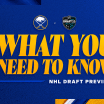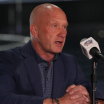Michael Leone – head coach
On biggest takeaway from his first AHL season
Leone, 37, joined the Amerks after two seasons with the USHL’s Green Bay Gamblers. In Year 1 as an AHL head coach, he learned a lot about the difficulty of the league – namely the physical play, the repetition of opponents and the travel schedule.
“I can see why a lot of teams like to send their prospects to the American League,” Leone said. “It hardens you and it seasons you, and you go through a lot of ups and downs.
“… Always dreamed about coaching in this league and fortunate for the opportunity. It was the best year I’ve ever had, just with our group, staff. I wish we were practicing in Charlotte right now.”
On Konsta Helenius and other prospects
Asked about Sabres prospects who made the biggest strides this season, Leone mentioned forwards Noah Ostlund, Anton Wahlberg and Konsta Helenius, as well as defensemen Nikita Novikov and Vsevolod Komarov. He spoke especially highly of Helenius, the 19-year-old who played some of his best hockey in the playoffs.
“He was incredible,” Leone said. “I thought he rose to the occasion; the bigger the moment, the better he played. I thought he played with a level of physicality. Ultimately, when you get to this time of the year, you find out who you are as a player. You work so hard to get to that end of the year, and you have to play a certain way to be successful. That’s what wins, and I thought Hele played a lot of winning hockey for us.”
On communication with the Sabres during the season
Leone estimates he attended 10 to 12 games at KeyBank Center this season. Those visits helped him communicate with Lindy Ruff, Kevyn Adams and other Sabres staff about Amerks players, but whether he was in Buffalo, Rochester or on the road, the head coach provided frequent updates about the development taking place under his watch.
“I think it was really important for me to try to get there (Buffalo) as much as I can,” Leone said. “I’d give them a lot of information before any guy was called up. Obviously their play would determine when they were called up, but just (to) give them information on how guys were doing, how our younger players were doing, and things like that.”


















